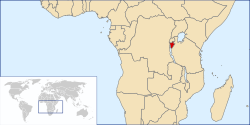Kingdom of Burundi
Kingdom of Burundi Koninkrijk Boeroendi (Dutch) Royaume du Burundi (French) Königreich Burundi (German) | |||||||||
|---|---|---|---|---|---|---|---|---|---|
| 1680–1966 | |||||||||
| Motto: Imana, Umwan, Uburundi Dieu, le Roi et le Burundi "God, the King and Burundi" | |||||||||
| Anthem: Burundi Bwacu (Our Burundi) | |||||||||
 Territory of the Kingdom of Burundi in 1966. | |||||||||
| Status | Independent state (1680–1890) Part of German East Africa (1890–1916) Part of Ruanda-Urundi (1916–1962) Independent state (1962–1966) | ||||||||
| Capital | Gitega Bujumbura | ||||||||
| Common languages | Kirundi, French, German (official from 1890–1916), Dutch (official from 1916–1962) | ||||||||
| Government | Monarchy | ||||||||
| Mwami | |||||||||
• 1680–1709 | Ntare I (first) | ||||||||
• 1966 | Ntare V (last) | ||||||||
| Prime Minister | |||||||||
• 1961 | Joseph Cimpaye (first) | ||||||||
• 1966 | Michel Micombero (last) | ||||||||
| Historical era | Cold War | ||||||||
• Established | 1680 | ||||||||
• German East Africa | July 1, 1890 | ||||||||
• Ruanda-Urundi | July 20, 1922 | ||||||||
• Autonomy | December 21, 1961 | ||||||||
• Independence | July 1, 1962 | ||||||||
• Republic | November 28 1966 | ||||||||
| ISO 3166 code | BI | ||||||||
| |||||||||
| Today part of | Burundi | ||||||||
The Kingdom of Burundi (French: Royaume du Burundi) or Kingdom of Urundi (Royaume d'Urundi) was a Bantu kingdom in the modern-day Republic of Burundi. The Ganwa monarchs (with the title of mwami) ruled over both Hutus and Tutsis. Created in the 17th century, the kingdom was preserved under European colonial rule in the late 19th and early 20th century and was an independent state between 1962 and 1966.
History[]
The date of the foundation of the Kingdom of Burundi is unknown but probably dates back to the 17th century when the Tutsi ethnic group gained dominance over the larger ethnic Hutu population of the region.[dubious ][citation needed] Under mwami Ntare I (r. 1675–1705), the kingdom expanded and annexed a number of surrounding polities.[1] Although ruled by the mwami, the kingdom was extensively decentralised and local sub-rulers had wide independence. Before the arrival of European colonists, succession struggles were also common.[1]
In 1890, Burundi became part of the German colonial empire as part of German East Africa but was not effectively occupied or controlled by the colonial power. During World War I, Belgian troops from the neighbouring Belgian Congo invaded the region and occupied it. The Belgians were awarded Burundi, together with the neighbouring Kingdom of Rwanda, as an international mandate by the League of Nations. The Belgians, however, preserved many of the kingdom's institutions intact.[1]
Whereas the similar Rwandan monarchy was abolished in a revolution between 1959 and 1961, the Burundian monarchy succeeded in surviving into the post-colonial period. In 1962, the Kingdom of Burundi regained its independence as a constitutional monarchy in which the mwami held executive power and legislative power was given to the parliament.[2] By late 1963, the Burundian government allowed Congolese revolutionary Gaston Soumialot to recruit thousands of fighters along the Burundian-Congolese border. Soumialot and his troops consequently participated in the Simba rebellion.[3]
Ethnic violence between the Hutu majority and the Tutsi minority rose between 1963 and 1965 and culminated with a failed coup d'état against the monarchy of Mwambutsa IV in 1965. Mwambutsa's son, Ntare V, deposed his father in a July 1966 coup d'état, but was himself ousted from power in a November 1966 coup d'état by his Prime Minister, Michel Micombero, who abolished the monarchy.[2]
Monarchs[]
Legacy[]
Most members of the royal house live in exile in France today. In the 2005 elections, Princess Esther Kamatari ran for president for the Party for the Restoration of Monarchy and Dialogue in Burundi (Abahuza). Supporters believe that a restoration of a constitutional monarchy could help to ease the country's ethnic tensions.[4]
The flag of the kingdom contained a karyenda in the center as a symbol of royal authority.[5]
See also[]
- History of Burundi
- Constitution of the Kingdom of Burundi
- Rosa Paula Iribagiza
References[]
- ^ a b c "Kingdom of Burundi". Encyclopædia Britannica (Online ed.). Retrieved 15 October 2016.
- ^ a b "Burundi: Fall of the Monarchy (1962 - 1966)". African Democracy Encyclopaedia Project. Retrieved 15 October 2016.
- ^ Villafana (2017), p. 71.
- ^ "Pro-monarchy party gets green light in Burundi". Panapress. 21 September 2004. Retrieved 15 October 2016.
- ^ Guide to the Flags of the World by Mauro Talocci, revised and updated by Whitney Smith (ISBN 0-688-01141-1), p. 153.
Works cited[]
- Villafana, Frank (2017) [1st pub. 2009]. Cold War in the Congo: The Confrontation of Cuban Military Forces, 1960-1967. Abingdon; New York City: Routledge. ISBN 978-1-4128-4766-7.
Further reading[]
- Gahama, Joseph (1983). Le Burundi sous administration belge: La periode du mandat, 1919-1939. Paris: Karthala. ISBN 9782865370894.
- Burundian monarchy
- Former monarchies of Africa
- 1860 establishments in Africa
- 1966 disestablishments in Africa
- States and territories established in 1860
- States and territories disestablished in 1966
- 17th-century establishments in Africa
- 1960s disestablishments in Burundi
- Former polities of the Cold War
- Former monarchies

